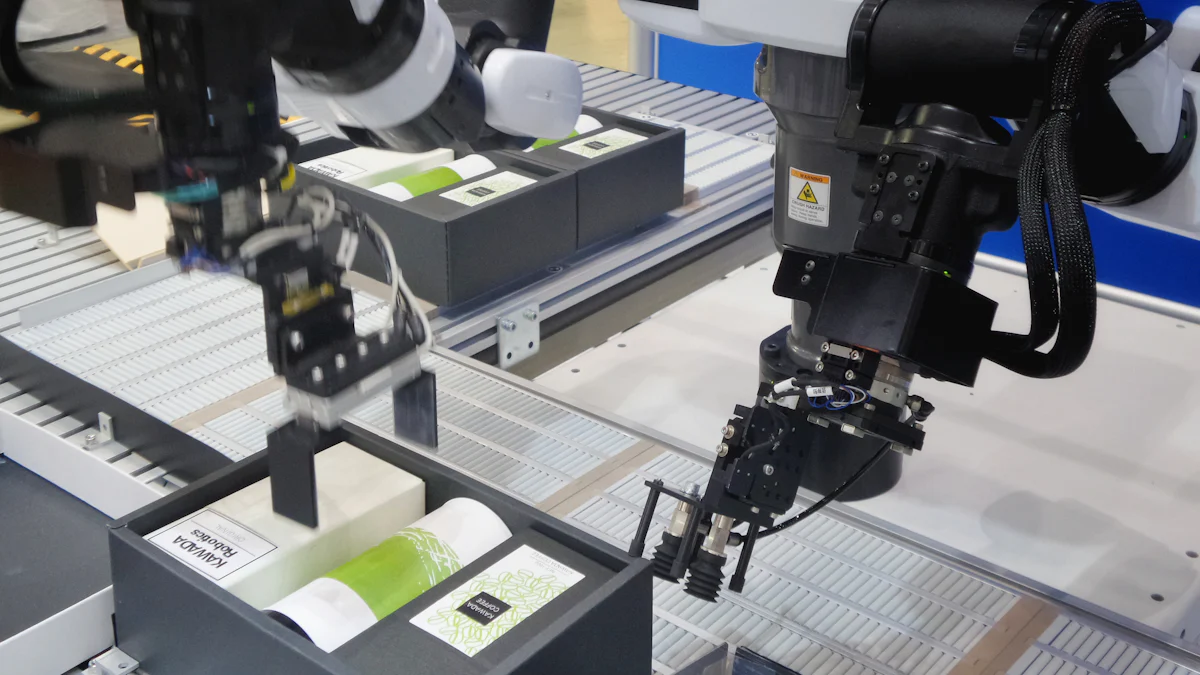Top 5 Cloud Technology Trends in Supply Chain Management

The evolution of cloud technology has revolutionized supply chain management, offering businesses unprecedented opportunities to enhance operational efficiency and strategic decision-making. Staying abreast of the latest trends in cloud technology is paramount for organizations seeking to maintain a competitive edge in today's dynamic market landscape. In this blog, we will delve into five pivotal trends reshaping supply chain management through the lens of cutting-edge cloud solutions.
Trend 1: AI and Machine Learning
Artificial intelligence (AI) and machine learning (ML) are at the forefront of transforming supply chain management practices. These technologies play a pivotal role in automating and optimizing various aspects of the supply chain process, from demand forecasting to inventory optimization and transportation network enhancement.
Enhanced Demand Forecasting
Predictive analytics powered by AI and ML algorithms enable organizations to forecast demand with unprecedented accuracy. By analyzing historical data patterns and market trends, businesses can anticipate future needs more efficiently, leading to optimized inventory levels and streamlined operations.
Real-time data analysis is another key benefit of AI and ML in demand forecasting. These technologies allow for the quick analysis of complex datasets, enabling real-time identification of sudden risks or trends. This capability empowers organizations to make timely decisions based on up-to-the-minute insights, enhancing their responsiveness to market dynamics.
Improved Decision Making
Automated insights provided by AI and ML tools offer valuable support for decision-making processes within the supply chain. By leveraging these technologies, organizations gain access to actionable intelligence derived from vast amounts of data. This automated analysis enhances strategic decision-making by providing valuable insights into operational efficiency and performance metrics.
Risk management is another critical area where AI and ML excel in supply chain management. These technologies help identify potential risks proactively by analyzing data at speeds that surpass human capabilities. By recognizing patterns in data quickly, organizations can mitigate risks effectively, ensuring smoother operations across the supply chain network.
Trend 2: Internet of Things (IoT)

Real-time Tracking
Asset monitoring is a critical aspect of supply chain management that has been significantly enhanced by the implementation of IoT technologies. By leveraging IoT sensors and devices, organizations can track the movement and condition of assets in real time, ensuring greater visibility and control over their inventory.
Inventory management is another area where IoT plays a transformative role. Through the integration of IoT devices with inventory systems, businesses can automate stock tracking, monitor levels accurately, and receive alerts for replenishment when necessary. This level of automation streamlines operations and reduces the likelihood of stockouts or overstock situations.
Data Collection
Sensor integration is key to effective data collection in supply chain operations. IoT sensors embedded in various points along the supply chain gather valuable information on factors like temperature, humidity, location, and movement. This data is then transmitted to centralized systems for analysis and decision-making.
Data analytics powered by IoT-generated data provide organizations with actionable insights into their supply chain performance. By analyzing trends, patterns, and anomalies in real time, businesses can make informed decisions to optimize processes, improve efficiency, and enhance overall operational effectiveness.
By embracing IoT technologies for real-time tracking and data collection, companies can unlock new levels of operational efficiency and responsiveness in their supply chain management practices. The ability to monitor assets continuously and collect valuable data insights empowers organizations to make proactive decisions that drive cost savings and enhance customer satisfaction.
Trend 3: Advanced Analytics
Big Data Utilization
Data Mining
In the realm of supply chain management, data mining plays a crucial role in extracting valuable insights from vast datasets. By utilizing advanced analytics tools, organizations can uncover patterns, trends, and correlations within their operational data. This process enables businesses to make informed decisions based on historical performance metrics and predictive analytics. Through data mining techniques, companies can identify areas for improvement, optimize resource allocation, and enhance overall efficiency across the supply chain network.
Trend Analysis
Trend analysis is a powerful tool that allows organizations to forecast future market dynamics and consumer behaviors. By examining historical data trends and patterns, businesses can anticipate shifts in demand, identify emerging opportunities, and mitigate potential risks proactively. Advanced analytics solutions enable real-time trend analysis by processing large volumes of data rapidly and accurately. This capability empowers decision-makers to adapt strategies swiftly in response to changing market conditions, ensuring agility and competitiveness in the dynamic supply chain landscape.
Performance Optimization
Process Improvement
Process improvement lies at the core of enhancing supply chain performance through advanced analytics. By leveraging data-driven insights, organizations can streamline workflows, eliminate bottlenecks, and enhance operational efficiency. Advanced analytics tools provide visibility into key performance indicators (KPIs), enabling continuous monitoring and optimization of critical processes. Through process improvement initiatives driven by advanced analytics, businesses can achieve cost savings, reduce lead times, and deliver superior customer experiences.
Cost Reduction
Cost reduction is a primary objective for supply chain management strategies leveraging advanced analytics capabilities. By identifying inefficiencies, redundancies, and areas of excessive spending through detailed cost analysis, organizations can implement targeted cost-saving measures. Advanced analytics solutions enable granular cost visibility across the entire supply chain ecosystem, facilitating informed decision-making to drive down operational expenses while maintaining service quality. Through proactive cost reduction strategies powered by advanced analytics insights, businesses can achieve sustainable profitability and competitive advantage in today's challenging business environment.
Trend 4: Robotics and Automation

Automated Warehousing
Robotics in Picking
Autonomous robots are transforming picking processes in warehouses by efficiently selecting items from shelves and bins. These robots utilize advanced algorithms to navigate through the warehouse, identify the required products, and retrieve them with precision. By automating the picking process, companies can significantly reduce errors, improve order accuracy, and enhance overall operational efficiency.
Robotics in Sorting
In sorting operations, autonomous robots play a crucial role in categorizing and organizing items for storage or shipping. These robots are equipped with sensors and cameras that enable them to identify different products based on predefined criteria. By automating the sorting process, businesses can streamline their operations, minimize manual handling, and accelerate order fulfillment. The use of robotics in sorting not only increases productivity but also ensures consistency and accuracy in inventory management.
Process Automation
Workflow Automation
Robotic process automation (RPA) is revolutionizing supply chain workflows by automating repetitive tasks and standardizing processes across various functions. RPA software bots mimic human actions to perform rule-based activities such as data entry, invoice processing, and order tracking. By implementing workflow automation through RPA, organizations can reduce manual errors, increase operational efficiency, and free up employees to focus on more strategic tasks.
Efficiency Gains
The integration of robotics and automation technologies leads to significant efficiency gains within supply chain operations. By streamlining workflows, minimizing downtime, and optimizing resource utilization, companies can achieve higher productivity levels and cost savings. Automation enhances the speed and accuracy of tasks such as inventory management, order processing, and shipment tracking. The efficiency gains derived from automation empower organizations to meet customer demands promptly while maintaining operational excellence.
By embracing robotics and automation in supply chain management practices, businesses can unlock new opportunities for growth, innovation, and competitiveness in today's dynamic market environment. The seamless integration of these technologies enables organizations to optimize their warehousing processes, automate routine tasks, and drive operational efficiencies throughout the entire supply chain network.
Trend 5: Cloud-based Management Platforms
In the realm of supply chain management, cloud technology continues to drive innovation and efficiency through cloud-based management platforms. These platforms offer unparalleled scalability and flexibility, empowering organizations to adapt to evolving market demands with agility and precision.
Scalability and Flexibility
Resource Management
Cloud-based solutions in supply chain management enable seamless resource allocation and utilization across diverse operational functions. By leveraging cloud platforms, businesses can optimize resource distribution based on real-time demand signals and performance metrics. This dynamic resource management approach enhances operational efficiency, minimizes waste, and maximizes productivity throughout the supply chain network.
Cost Efficiency
Cost efficiency is a key advantage of cloud-based management platforms in supply chain operations. By transitioning to cloud solutions, organizations can reduce capital expenditures associated with traditional IT infrastructure while gaining access to scalable resources on a pay-as-you-go basis. This cost-effective model allows businesses to align their expenses with actual usage, optimize operational costs, and achieve sustainable profitability in a competitive marketplace.
Global Communication
Collaboration Tools
Cloud-based management platforms facilitate seamless collaboration among stakeholders within the supply chain ecosystem. Through integrated communication tools and shared workspaces, teams can collaborate in real time, exchange critical information, and coordinate activities efficiently. This enhanced collaboration fosters transparency, improves decision-making processes, and accelerates response times to market dynamics.
Real-time Updates
Real-time data updates are essential for agile decision-making in supply chain management. Cloud-based platforms provide instant access to updated information on inventory levels, order statuses, and shipment tracking. By leveraging real-time updates, organizations can proactively address disruptions, optimize logistics processes, and enhance customer service levels. The ability to make informed decisions based on current data ensures operational resilience and responsiveness in today's fast-paced business environment.
Cloud technology serves as a transformative catalyst in modern supply chain management, optimizing operations and enhancing efficiency. By leveraging computationally intensive tools effectively, businesses can streamline processes and minimize risks. The cloud's scalability, cost-efficiency, and collaboration benefits revolutionize logistics paradigms, ensuring high standards of quality management are consistently met. This technology centralizes data from various sources into a single platform, offering accessibility, visibility, and speed in supply chain operations. Embracing cloud-based solutions is essential for companies looking to stay competitive and agile in today's dynamic market landscape.
See Also
Revolutionizing Industries with Cloud-Based Supply Chain Solutions
5 Key Trends Shaping Future Supply Chain Efficiency
Reshaping Industries Through Cloud-Based Supply Chain Solutions
Transforming Supply Chain Management with Cloud Solutions
Unveiling 5 Cutting-Edge Supply Chain Optimization Strategies
